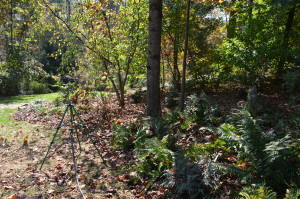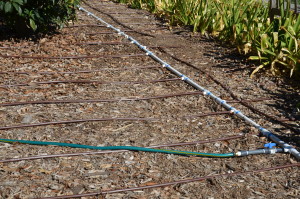Modern gardeners are using more efficient drip irrigation or soaker hoses. Water bills are less than overhead or oscillating systems. You may opt to attach the hose to an automatic timer so you can irrigate in absentia. Water goes on and off anytime you select.
In garden beds water plants deeply once weekly rather than a little bit every day. During the summer months, daily or twice-daily watering may be needed for annuals and perennials growing in hanging baskets, window boxes. Newly planted and large container-grown small trees and shrubs may need a drink.
Over a dry summer, long season vegetables demand deep watering to yield tomatoes, squash, pumpkins, cucumbers, etal. Rhubarb, asparagus, and many perennial herbs need summer moisture to survive cold winters. In late fall rhododendrons, azaleas, blueberries, and other shallow rooted plants should be deeply irrigated before heading into a dry cold winter.
How much water do garden plants require? Most summer annuals need an inch of water weekly—either supplied by natural rainfall or through a hose. Never waste water, no matter how full your city’s reservoir supply; don’t send water down the driveway or street gutter. Mulching plants aids to lower water use.
By mid-July, plants growing in containers require almost daily watering. Some container grown plants like daphnes or hostas are not forgiving if you miss a scheduled waterings, while agaves don’t seem to care. Bigleaf hydrangeas (Hydrangea macrophylla) or ligularias may be seen wilting in the mid-day sun, but fully recover by evening. Repotting plants into larger containers also helps.
Early morning is the best time to water by hand or by an oscillating sprinkler. Plant foliage has adequate time to dry off, reducing potential problems with fungal and bacterial diseases. Disease causing spores require moisture on the leaf surfaces. Snail and slug injury is worse by irrigating in late day or at night.
Finally, the more that you irrigate, nutrients, particularly nitrogen, are leached out of the root zone. New fertilizer must be applied for plants to continue growing and not suffer from nutrient deficiencies. Overwatering leads to root and crown rot problems.



 Posted in
Posted in 
